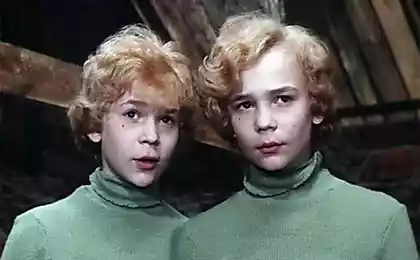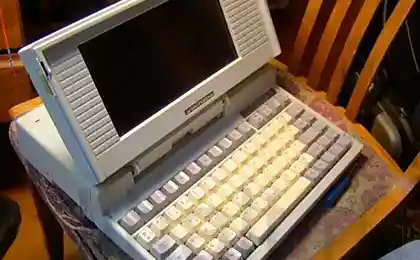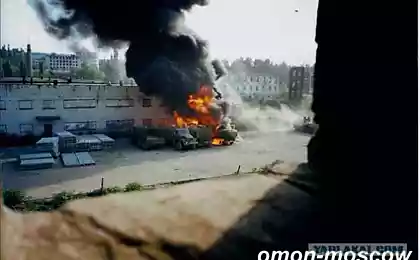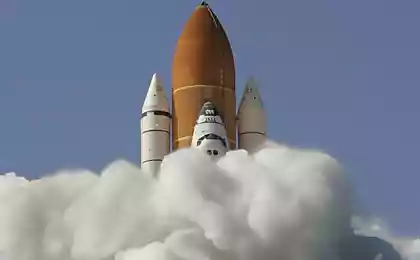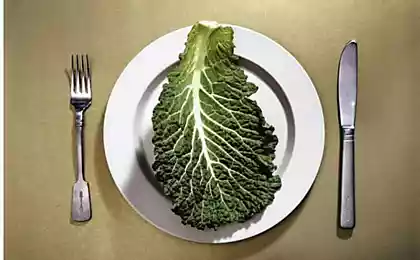1214
This is Science: Put Triboelectricity the service of humanity
Apparently, this is the principle group of Professor Wang ( Wang ), which successfully combines work at the Beijing Institute nanoenergetiki and Nanosystems and Technology University of Georgia, elected its maxim. Over the past six months in the light appeared in a total of 7 works only in the Journal of the American Chemical Society ACSNano (impact factor 12.062), about them -That we are today and we'll talk. Especially because these systems Immersed real chance to become the primary powering wearable sensors and smart clothes.
Instead preface h4> At the beginning of the year was published and her brief retelling Habré about getting power at the expense of triboelectricity. It looked then like some exotic, perhaps not having the normal use of the national economy, although the authors pointed out that on the basis of development, you can create, for example, an autonomous weather station. Imagine my surprise when, in abundance, began to crumble articles in top journals in which was proposed many ways to use static electricity.
But start with the principal - a brief excursion into physics and material repetition of the previous article. So many of us have encountered in everyday life with the phenomenon Triboelectricity , ie electricity (or more precisely, the charge separation ) that occurs when two friction materials or substances (e.g., with different densities). This is a charge separation can be described by two main characteristics: in fact, the magnitude of the charge (or current) and the potential difference. Of course, these characteristics depend on many parameters: humidity, temperature, nature of the used materials and so on.
If you, dear worshiper Habra, have homes synthetic blanket-blanket, in the darkness, going through this blanket, you can see the spark slips between the body or individual portions thereof, as well as smell the "storm" (ozone) and nitrogen oxides. Similar examples - experiences from the channel "Simple Science» Bredun :
Or here's another:
Normally, the lessons of physics at school, this effect is presented as something useless or even harmful (eg, computer equipment, aviation), but it is not so - let's look at an example.
Hört ihr mich? h4> «Can you hear me?" - as one song sung in German band Rammstein. Yes, we said the authors of confidence, suggested using tribogenerator for samozapityvayuschegosya microphone, acoustic positioning of the body and more acoustic weights.
Scheme developed device is presented below. It is worth noting that it is a little different from the usual all our микрофона, the only difference is that instead of electromagnetic effects, such as changing the induction or capacitance of the capacitor, the measured characteristic is like the case of the tribogeneratorom , current.

The circuit device samozapityvayuschegosya microphone and the detector acoustic wave (PET - Polyethylene terephthalate, PTFE - Teflon) i>
Of course, it has been identified and acoustic characteristics. Naturally, the higher the volume (the closer to the sound source to the microphone), the better a microphone, but do not forget that the device does not require an external power supply, the signal can potentially be amplified receiver.

electric and acoustic characteristics of the resulting device: (a) the open circuit voltage, (b) short-circuit current, © these characteristics depending on the distance from the active element and (d) the radiation pattern microphone i>
As soon as the microphone has a directional pattern, sin is not based on it to create a sound source position detector, with samozapityvayuschiysya. Actually, that was done on the basis of correlations between several signal sources:

Example of a device for detecting the sound source i>
And that's not all, as this type of membrane can be used for weighing objects through sound, as demonstrated in this video . Scientists have achieved sensitivity of 270 mV / mg, weighing weight from 40 mg to 400 mg. In principle, these scales may find its application in the jewelry industry because of the extremely low price and high sensitivity.
Video of the position detector and the microphone sound can be viewed on the official website or Yandex-Disk .
Original article in ACSNano (DOI: 10.1021 / nn4063616). i>
back and forth and back, you and me - electricity. h4>

(a, b) Scheme of the triboelectric generator. (a-e) polymer film ( Kapton ) with copper contacts assembled and disassembled i>
This device looks like a little hum-hum ... sexy, but what to do, science requires sacrifice. If in the first article polymer plate with a small portion of copper fluctuated between two electrodes, now the electric charge is accumulated in the movement of the two polymer films with respect other, as shown in Figure:

The principle of the triboelectric generator (a), and simulation data for a given system (bf). i>
The authors also published a couple of video (you can see from the official website of the publishing house or Yandex-Disk ), both can be operated by the movement of waves tribogenerator or person.
Although the maximum output power is only 10-12 mW (1.36 W / m 2 sup>) at a current of 300 mA and about at a speed of 1 m / s demonstrated the device, it can potentially be used for navigation beacons and, you never know, in wearable "smart" clothing to recharge the built-cardiometry or tracker, for example. More on that in the very end of the article.
Original article in ACSNano (DOI: 10.1021 / nn500694y). i>
A logical extension of this work was the development of two models generator of electricity using waves and rain.
In the first case, a wave rolls brings some charge that "absorbed" by the polymer film of a fluorinated polyethylene propylene ( FEP ), as shown in Figure:

The scheme of the triboelectric generator based on tidal waves i>
The power of the generator is at the level of units of W / m 2 sup>, but given the fact that such a plant may be located along the coast of unused, prospects, in principle, encouraging and enticing. In addition, rain or flowing water can also be used to generate electricity - video ( official website of the publisher or Yandex-Disk ).
Original article in ACSNano (DOI: 10.1021 / nn5012732). i>
In the second case, it uses a more sophisticated dual system that allows you to convert not only the electrostatic energy of the rolling drops, but also to receive energy from the shock interaction with the surface of the droplets.
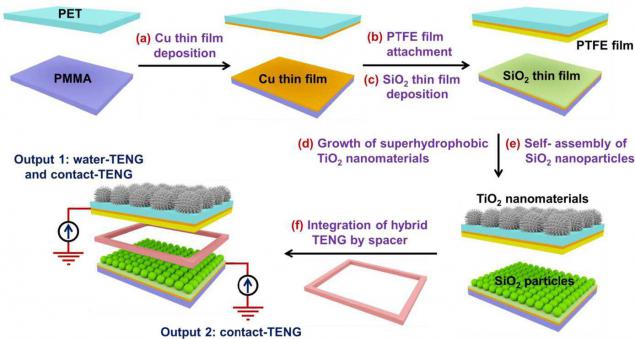
The general scheme of a bypass triboelectric generator: the first circuit - nanoparticles of titanium dioxide, providing nesmachivaemost surface and rolling drops of rain, the second circuit - silica nanoparticles in contact with PTFE film with the impact of a falling drop i>
A drop falling on the inclined surface of the generator, carries with it some charge (say positive), and in the process of digging on the surface of the electrified polymer film (or negative), and a copper electrode "collects" the excess negative charge. The second circuit operates on the principle described several times above: silica nanoparticles impact contact with the Teflon film, creating a potential difference and electrifying. Details of the two circuits separately in schematic form presented below:
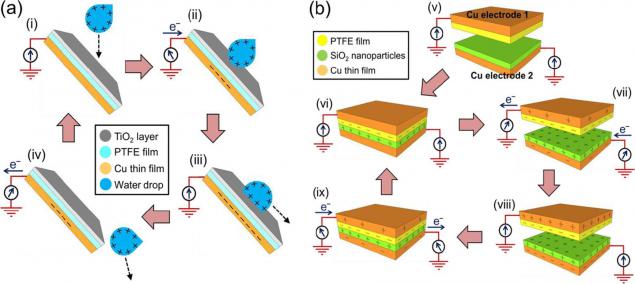
Ultimately, the primary circuit gives a power of about 1.3 W / m 2 sup>, while the contour dispose of the mechanical energy of the drops can further get up to 0.3-0.4 W / m 2 sup>. Moreover, based on such systems can be created samozapityvayuschiesya sensors of different molecules. In particular, the article gives an example of the ethanol sensor, allowing to determine the fraction of one percent of this compound. And in terms of big cities it can be sensors of various gases to determine the ecological status of vozduzha.
Video showing the operation of the device can be viewed on the official website publishing or c Yandex-Disk .
Original article in ACSNano (DOI: 10.1021 / nn501983s). i>
Towards a wearable charging system h4> The last couple of articles to date, of which I would like to tell you, in fact, devoted to the prototype charging that a couple of years can be integrated into our everyday clothes for the smart elements of clothing.

The scheme to develop the concept of triboelectricity due to compression and stretching i>
The essence of this design is that when compressed or stretched again arises Triboelectricity static or which may be stored during walking or running, and directed, for example, to charge your smart phone, lying in the pocket. In principle, such systems may also be used to generate electricity from dripping or falling tides, as demonstrated above. Although power output is not so large (~ 0.4 W / m 2 sup>), it was enough to ensure that power the LED array in the conducted experiments (see. Video ).
Also, the authors have published some videos demonstrating the operation of the device, which can be viewed on the official website publishing or Yandex-Disk .
Original article in ACSNano (DOI: 10.1021 / nn502618f). i>
However, the maximum capacity of the above platforms to develop triboelectricity is achieved at a frequency rate of more than 100 Hz, which is, you see, is more interesting for the athletes, but in the second the scientists have created a fabric based on conventional cotton yarns, which allows you to generate electricity at the expense of muscle contractions during walking, for example, or a simple pat.
The new fabric, which allows to generate electricity: special fiber woven into conventional cotton i>
In this case, the cotton fibers are first coated with carbon nanotubes, and then a part of them additionally Teflon. Next, a pair of fibers woven into the normal tissue and can operate as a generator triboelectricity due to friction and moving fibers each other.
Electric principle of the two fibers for triboelectricity i>
Again worth to mention that the power density of these devices is not as great as we would like, as well as the stored charge - only a few nC half a minute, however, this is enough to revive the monochrome display simple flick of a finger (see. Video ).
Alternatively, such a small amount of electricity may be sufficient for some sensor built into clothing, such as a thermometer, for activation only enough pat tribogeneratora location.
Wearable samozapityvayuschiysya thermometer - one more step to the wearable electronics i>
Video demonstrations are available on the official website of the publishing house or Yandex-Disk .
Original article in ACSNano (DOI: 10.1021 / nn501732z) i> They'll find your data development application?
Yes, in converting electricity Yes, eneregonezavisimyh, compact systems Yes in wearable electronics to charge devices Yes, wearable electronics to power sensors No, I do not find. Completely hopeless idea Difficult to answer. Only registered users can participate in the survey. Sign , please. Voted 151 people. 57 people abstained. Source: habrahabr.ru/post/231211/





















